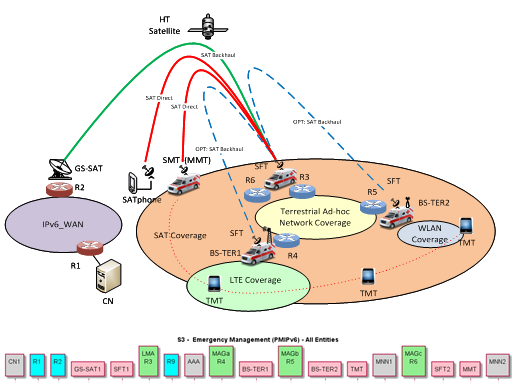PAGE CONTENTS
Objectives
The project has studied different integrated heterogeneous satellite terrestrial scenarios where new Internet based protocols for supporting user terminal mobility during provision of various end-users’ communications services will bring significant performance and/or cost improvements, in particular for High Throughput Satellites.
The objective of this project is to demonstrate the potential of using advanced mobility management protocols specified by IETF in hybrid satellite-terrestrial networks, emulated by a real-time test bed.
A real-time testbed has been developed for validating the proposed concepts, comprising all components required for investigating intra- and inter- network mobility for satellite and integrated satellite-terrestrial communication networks, based on emulated satcom and terrestrial mobile links.
The test bed SW can be re-used in subsequent ESA activities or by third parties, belonging to ESA Member States, for research or commercial products.
Challenges
The key issue in this project is the selection of the most promising mobility scenarios and the development of a real-time test bed for validating these scenarios in an integrated satellite-terrestrial communication network. The test bed must be flexible enough to emulate in real-time the various advanced mobility management protocols and evaluate their technical performance, particularly the link latency, connection outages and packet losses.
The analysis of the economic impact and market attractiveness of the selected mobility management solutions is a further challenge in this project.
SYSTEM ARCHITECTURE
The testbed comprises all relevant mobility entities specified by IETF RFCs for advanced mobility management protocols enabling the real-time emulation of various advanced mobility management scenarios while minimizing the re-configuration efforts.
The implementation of the testbed consists of hardware and software components. These components are described in detail in the following sections. For clarity purposes, some conventions are used. These conventions are explicitly marked in the text.
Four main parts build the AMP testbed:
- Virtual Machine Host (VM-Host)
- Simple LAN Switch (SSW)
- Manageable Switch (MSW)
- JAR Network Emulator (JAR)
The VM-Host is responsible for hosting virtual machines representing the entities required for the certain validation scenario. A manageable switch connected to the VM-Host allows integrating physical entities (e.g. PC’s, Laptops) into the testbed. To emulate various aspects of L2 network links between L3 entities (like bandwidth, jitter or packet drop) JAR is also connected to the managed switch. A simple LAN switch is used to connect all components for management purposes. All physical testbed components are 19” rack mountable, leading to a very compact design.
The following figures show exemplary the functional architecture of the validation testbed for the scenario “Emergency Management” and the corresponding end-to-end entities.

Final Report provides more details on system architecture.
Plan
Following a comprehensive analysis of the IETF RFCs and outcomes from other relevant ESA projects, this project has produced a set of deliverables related to network mobility in heterogeneous environment alongside with an analysis of existing architectures, protocols and solutions and development of several candidate mobility scenarios and architectures that are particularly promising in the combined satellite-terrestrial environment. Subsequently two scenarios have been selected and validated using real-time test-bed produced for this purpose.
The activity comprises following tasks:
- T1:Mobility management architectures
- T2: Integration of mobility support solutions into satellite networks
- T3: Detailed architectures
- T4:Future work recommendations, technology development roadmap and standards evolution
Current Status
The activity is completed.
From the beginning of the project “Advanced mobility management protocols (AMP)” a full set of deliverables according to the SoW has been produced, reviewed, accepted and delivered to ESA comprising following documents:
- TN1: Architectures and protocols review
- TN2: Integration scenarios
- TN3.1: Detailed architectures
- TN3.2: Validation requirements, framework and test bed(s) design
- TN3.3: Validation results
- Test bed(s) datasheets, installation instructions and user manuals
- TN3.4: Analysis of cost effectiveness and economic gains vs constraints
- TN 4: Future work recommendations, technology roadmap and standards evolution
The validation testbed hardware has been configured, required software implemented and installed, followed by comprehensive validation test campaigns for the selected integrated mobility concepts.
The compliance of the testbed implementation against validation requirements (TN3.2) has been successfully closed.
Furthermore a User Manual (UM) has been produced, reviewed and accepted by ESA. The UM will assist third parties with basic networking know-how to set up further use cases evaluating various hybrid mobility solutions.
Finally the pre-configured validation testbed has been delivered to ESA.
Related Links
Companies
